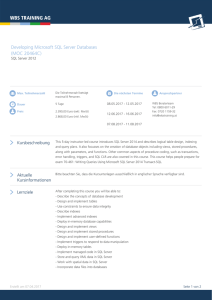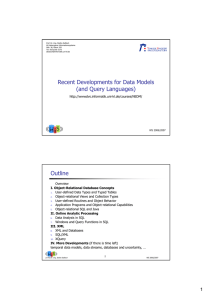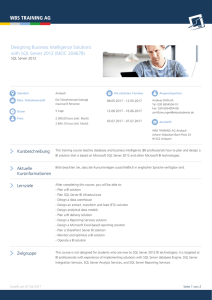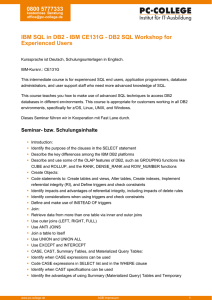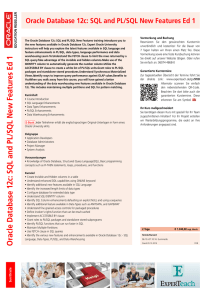Embedded SQL - auf der DBIS Startseite
Werbung
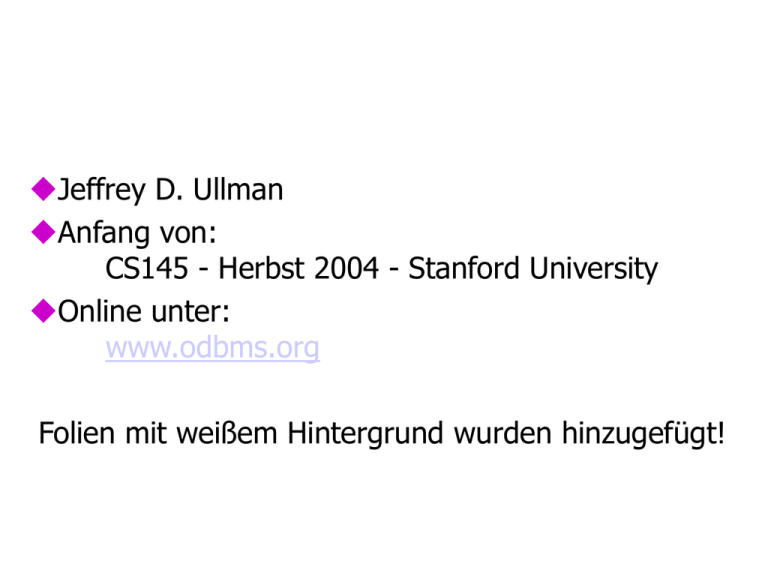
Jeffrey D. Ullman
Anfang von:
CS145 - Herbst 2004 - Stanford University
Online unter:
www.odbms.org
Folien mit weißem Hintergrund wurden hinzugefügt!
Real SQL Programming
Embedded SQL
Call-Level Interface
Java Database Connectivity
2
SQL in Real Programs
We have seen only how SQL is used at
the generic query interface --- an
environment where we sit at a terminal
and ask queries of a database.
Reality is almost always different.
Programs in a conventional language like C
are written to access a database by “calls”
to SQL statements.
3
Host Languages
Any conventional language can be a
host language, that is, a language in
which SQL calls are embedded.
The use of a host/SQL combination
allows us to do anything computable,
yet still get the very-high-level SQL
interface to the database.
4
Kommt man auch ohne host
language aus?
Abhängig vom SQL Standard
Theorie sagt: Mit “if” (Bedingung) und “while”
(Schleife) kriege ich alles hin!
SQL92 bietet dies nicht z.B. Berechnung der
Fakultät nicht möglich (n!).
IBM DB2 erlaubt mitlerweile rekursives SQL
(nach SQL3)
… wie auch immer, host language bietet viele
Vorteile!
5
Connecting SQL to the Host
Language
1. Embedded SQL is a standard for
combining SQL with seven languages.
2. CLI (Call-Level Interface ) is a
different approach to connecting C to
an SQL database.
3. JDBC (Java Database Connectivity ) is
a way to connect Java with an SQL
database.
6
Bemerkungen
CLI beschreibt wie aufgerufen wird, es
ist nicht auf C beschränkt!
JDBC basiert ebenfalls auf CLI ist
eine Umsetzung des CLI in Java
Mehr hierzu in der nächsten Vorlesung!
7
Embedded SQL
Key idea: Use a preprocessor to turn
SQL statements into procedure calls
that fit with the host-language code
surrounding.
All embedded SQL statements begin
with EXEC SQL, so the preprocessor can
find them easily.
8
Quelltext mit
SQL-Befehlen
Precompiler
SQL
LIB
STD
LIB
Quelltext in
reiner host
language
Compiler
Objektdatei
Linker
Ausführbares
Programm
9
Shared Variables
To connect SQL and the host-language
program, the two parts must share
some variables.
Declarations of shared variables are
bracketed by:
EXEC SQL BEGIN DECLARE SECTION;
Always
<host-language declarations>
needed
EXEC SQL END DECLARE SECTION;
10
Use of Shared Variables
In SQL, the shared variables must be
preceded by a colon.
They may be used as constants provided
by the host-language program.
They may get values from SQL statements
and pass those values to the host-language
program.
In the host language, shared variables
behave like any other variable.
11
Example: Looking Up Prices
We’ll use C with embedded SQL to
sketch the important parts of a function
that obtains a beer and a bar, and looks
up the price of that beer at that bar.
Assumes database has our usual
Sells(bar, beer, price) relation.
12
Example: C Plus SQL
EXEC SQL BEGIN DECLARE SECTION; Note 21-char
char theBar[21], theBeer[21];
arrays needed
for 20 chars +
float thePrice;
endmarker
EXEC SQL END DECLARE SECTION;
/* obtain values for theBar and theBeer */
EXEC SQL SELECT price INTO :thePrice
FROM Sells
WHERE bar = :theBar AND beer = :theBeer;
/* do something with thePrice */
SELECT-INTO
13
just like PSM
Embedded Queries
Embedded SQL has the same
limitations as PSM regarding queries:
You may use SELECT-INTO for a query
guaranteed to produce a single tuple.
Otherwise, you have to use a cursor.
• Small syntactic differences between PSM and
Embedded SQL cursors, but the key ideas are
identical.
14
Cursor Statements
Declare a cursor c with:
EXEC SQL DECLARE c CURSOR FOR <query>;
Open and close cursor c with:
EXEC SQL OPEN CURSOR c;
EXEC SQL CLOSE CURSOR c;
Fetch from c by:
EXEC SQL FETCH c INTO <variable(s)>;
Macro NOT FOUND is true if and only if the FETCH
fails to find a tuple.
15
Example --- (1)
Let’s write C + SQL to print Joe’s menu
--- the list of beer-price pairs that we
find in Sells(bar, beer, price) with bar =
Joe’s Bar.
A cursor will visit each Sells tuple that
has bar = Joe’s Bar.
16
Example --- (2: Declarations)
EXEC SQL BEGIN DECLARE SECTION;
char theBeer[21]; float thePrice;
EXEC SQL END DECLARE SECTION;
EXEC SQL DECLARE c CURSOR FOR
SELECT beer, price FROM Sells
WHERE bar = ’Joe’’s Bar’;
The cursor declaration goes
outside the declare-section
17
Example --- (3: Executable)
EXEC SQL OPEN CURSOR c;
The C style
of breaking
while(1) {
loops
EXEC SQL FETCH c
INTO :theBeer, :thePrice;
if (NOT FOUND) break;
/* format and print theBeer and thePrice */
}
EXEC SQL CLOSE CURSOR c;
18
